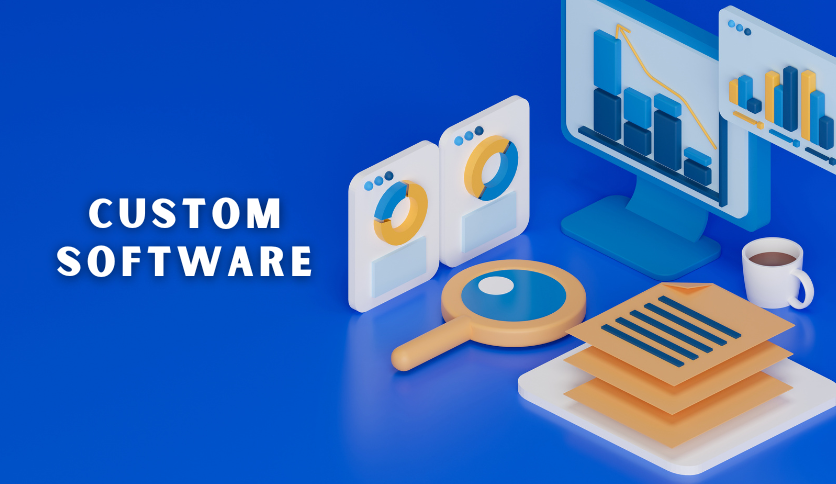Major tech companies such as Amazon, Google and Tesla have invested billions of dollars in custom software development. They break away from general software and build their own solutions to improve efficiency, expand quickly and protect sensitive data. However, this strategy is not limited to large companies. SMEs can benefit from custom software, make their operations smoother, and make profits.
This blog explores why tech giants are making these shifts, what advantages custom software brings, and why companies of all sizes should consider this approach.
Why Big Companies Are Moving Away from Generic Software?
Most companies use pre-developed software packages, commonly known as off-the-shelf software. These are general-purpose tools, like accounting packages, customer relationship management systems, and project management software.
Although these are convenient options, they possess serious drawbacks:
- Lack of flexibility: Businesses have to adjust their processes to fit the software, rather than the other way around.
- Unnecessary features: Off-the-shelf software often includes features that companies never use but still pay for.
- Scalability issues: As companies grow, they may need more advanced functions that generic software cannot provide.
- Security risks: Using third-party software means trusting external providers with sensitive data.
- Higher long-term costs – Subscription fees for multiple software tools can add up over time.
Big tech companies recognize these issues and are choosing to build their own custom software—solutions designed specifically for their unique business needs.
How Big Tech Uses Custom Software to Stay Ahead
To understand why custom software is so powerful, let’s look at real-world examples of how leading companies use it to their advantage.
Amazon: Streamlining Logistics for Faster Deliveries

Amazon is the largest online retailer in the world, shipping millions of packages a day. Part of its success is its very efficient supply system. Unlike many firms that farm out inventory and shipping management to third-party software programs, Amazon developed its own proprietary warehouse management system to store everything through delivery.
Here’s how Amazon’s custom software gives them an advantage:
1. Real-Time Inventory Tracking
Amazon manages hundreds of fulfillment centers worldwide. Without a proper system in place, keeping track of stock levels would be nearly impossible.
Their custom-built software enables real-time inventory tracking, ensuring that:
- Every product is scanned and recorded the moment it enters or leaves a warehouse.
- When shopping online, customers can see accurate stock levels
- When stocks are running low, automated alerts notify warehouse managers
This tracking system improves overall customer satisfaction to minimize overselling, stockouts, and delayed shipments.
2. Optimizing Storage Space in Warehouses
Amazon’s warehouses are designed to maximize storage space while keeping items accessible. Instead of using a traditional system where similar products are stored together, Amazon’s custom software determines the most efficient way to store items based on:
- Size and weight: Larger items are placed in easy access areas to reduce handling time.
- Sales frequency: Popular items are kept near packing stations for faster retrieval.
- Product category: Some items (like fragile goods) require special handling and are stored in designated areas.
By using machine learning algorithms, Amazon continuously improves its storage efficiency.
3. Automated Packaging and Shipping
Packing and shipping millions of orders daily require extreme precision. Amazon’s custom-built software integrates with robotic systems that:
- Select the right box size for each order to minimize waste and shipping costs.
- Automatically print shipping labels with the correct delivery details.
- Sort packages based on the most efficient delivery route.
This level of automation allows Amazon to process orders faster and with fewer errors, reducing labor costs and improving delivery speeds.
4. Reducing Delivery Times with Advanced Routing Algorithms
Amazon’s delivery network is one of the most advance systems in the world. Amazon has its own routing software Instead of relying on external logistics companies to:
- Find the fastest delivery routes using real-time traffic and weather data.
- Distribute packages strategically across different fulfillment centers.
- Assign deliveries to Amazon Flex drivers based on location and availability.
Amazon guarantees faster, cheaper, and more reliable deliveries with complete control over the entire logistics process.
Google: Handling Massive Data with Custom Tools

Google processes billions of searches, emails, and video streams daily. They are managing the unimaginable amount of data, and using pre-made software would slow them down.
To handle this enormous workload, Google has developed its own custom tools, which allow them to:
1. Store and Process Data at High Speeds
Google’s search engine needs to index and retrieve information from millions of websites within seconds. To achieve this, they built:
- Bigtable: A custom database system that organizes and processes large amounts of data quickly.
- MapReduce: A tool that breaks down huge tasks into smaller ones, allowing them to be processed faster.
These tools enable Google to deliver fast and accurate search results in a fraction of a second.
2. Managing Security Risks Effectively
Handling vast amounts of data also comes with security challenges. Google’s custom-built security software helps:
- Detect unusual login attempts and block hackers.
- Protect users from phishing attacks and malware.
- Encrypt emails, search queries, and personal data to keep user information safe.
Google minimizes the risk of breaches to control its own security systems, that could expose sensitive data.
3. Personalizing Search Results and Advertising
Google’s revenue depends heavily on advertising. Instead of using a generic ad-placement system, they built their own ad-targeting software, which:
- Analyzes user search behavior and preferences.
- Shows personalized ads based on interests.
- Tracks ad performance and improves recommendations over time.
This level of data-driven personalization makes Google’s advertising platform one of the most powerful in the world.
Tesla: Building Smarter Cars with Custom Software

Tesla's Autopilot and Full Self-Driving (FSD) capabilities are based on strong software that:
- Handles real-time data from sensors and cameras.
- Detects pedestrians, traffic signs, and obstacles.
- Takes split-second driving decisions with no human input.
Since Tesla owns their autonomous software, they are free to update it and make adjustments constantly—receiving a large edge over everyone else.
2. Continuous Over-the-Air Updates
Most cars require a visit to a dealership for software updates. Tesla, however, updates its vehicles remotely, just like a smartphone.
These updates can:
- Improve battery performance.
- Add new driving features.
- Fix security vulnerabilities.
Tesla reduces costs and keeps cars up to date without inconvenience to the owner by eliminating the need for in-person maintenance.
3. Monitoring Car Performance and Battery Efficiency
Tesla’s software constantly tracks:
- Battery health – Helping owners maximize battery life.
- Energy consumption – Allowing drivers to optimize driving habits.
- Predictive maintenance – Detecting potential issues before they become serious problems.
How Custom Software Helps Businesses Save Money?

Many businesses avoid custom software because they believe it’s too expensive. However, in the long run, it actually reduces costs in several ways:
1. Lower Software Subscription Costs
Off-the-shelf software usually requires monthly or yearly payments. As businesses grow, these costs add up.
Custom software eliminates the need for multiple software subscriptions, saving money in the long term.
2. Automating Manual Tasks
Many businesses spend time and money on repetitive tasks like:
- Data entry
- Scheduling
- Generating invoices
Custom software automates these processes, reducing labor costs and minimizing errors.
3. Improving Overall Efficiency
Employees work faster when using software that fits their workflow rather than adapting to generic software.
This leads to:
- Higher productivity
- Fewer mistakes
- Less time wasted on unnecessary steps
4. Eliminating Unused Features
Many businesses pay for software with features they never use. Custom software includes only what’s necessary, making it more cost-effective.
How Startups and Small Businesses Can Use Custom Software?

Most small business owners believe that custom software is just for large firms with substantial budgets. Historically, that has been true since developing software from scratch involved lots of money and time. However, things are different now; custom software is cheaper and more accessible than ever. Small businesses can utilize it to make their operations more efficient, cut down on expenses, and increase their growth rates.
This is the way in which startups and small companies can begin applying custom software to address actual business issues without breaking the bank.
1. Identify the Biggest Challenges in Your Business
Before investing in any software, identify the biggest problems in your business. Custom software is most useful when it solves specific challenges that are slowing you down.
Common problems that custom software can fix:
- Slow order processing – If it takes too long to fulfill orders, customers may leave for competitors.
- Poor customer service response times – Customers expect quick replies, but answering manually takes time.
- Difficulty managing finances – Tracking expenses and invoices manually can lead to mistakes.
- Repetitive manual tasks – Entering data, generating reports, and sending emails manually wastes time.
By identifying these challenges, businesses can build software that directly addresses their needs, making their operations smoother and more efficient.
2. Start with a Small Custom Solution
One of the biggest mistakes small businesses make is thinking they need a large and complex system right away. Instead, start small by focusing on a single issue.
Example:
- If customers complain about slow responses, build a simple chatbot to answer frequently asked questions.
- If order processing takes too long, create an automated tracking system.
- If invoices are hard to manage, set up a tool that sends automatic payment reminders.
By starting with a small tool, businesses can test its impact before committing to bigger investments. If the solution works well, they can expand it step by step.
3. Use No-Code and Low-Code Tools to Reduce Costs
In the past, building custom software required a team of experienced programmers. But today, no-code and low-code platforms allow businesses to create software without needing deep technical skills.
Popular no-code and low-code tools:
- Bubble – Helps businesses build web applications without writing code.
- Zapier – Connects different apps to automate workflows.
- Airtable – A flexible database system for organizing business data.
- Glide – Turns spreadsheets into simple mobile apps.
Using these tools, small businesses can build custom solutions in days or weeks instead of months, saving both time and money.
4. Work with Experienced Developers for Advanced Solutions
While no-code tools work for simple applications, some businesses may need more advanced solutions that require professional developers.
If your business needs custom features, better security, or integration with other systems, hiring an experienced developer or a small software development team is the best option.
How to find the right development team:
- Look for developers with experience in your industry – They will better understand your needs.
- Start with a small project – Test their work before committing to a long-term contract.
- Choose developers who offer long-term support – Software needs updates and improvements over time.
By working with the right team, businesses can get a high-quality custom solution that fits their specific needs without unnecessary features or expenses.
The Future of Custom Software

Technology is advancing faster than ever, and more businesses are shifting towards custom-built solutions. Here are some of the biggest trends shaping the future of custom software development.
1. AI-Driven Custom Software
Artificial intelligence (AI) is revolutionizing the way companies engage with customers, handle data, and make decisions. Increasingly, more companies will leverage AI-powered custom software to:
- Foresee customer behavior: AI can scrutinize previous purchases and browsing history to recommend items customers are most likely to purchase.
- Streamline intricate decision-making: Companies can utilize AI to automate loan approvals, identify fraud, and review financial risks.
- Personalize customer experiences: AI can suggest content, products, and services to customers based on their preferences.
Small and medium-sized enterprises too can leverage AI technologies that assist them in data analysis and customer service.
2. Blockchain for Security and Transparency
Blockchain technology is most famously known to underlie cryptocurrencies, but companies are now employing it for security and transparency in data.
- Secure transactions: Blockchain can secure online payments from tampering.
- Improved record-keeping: Companies can securely keep contracts, accounting data, and customer information.
- Transparent supply chain: Firms can follow goods from vendors to customers to ascertain product genuineness.
With the expansion in cybersecurity attacks, increasing numbers of companies will shift towards blockchain solutions to ensure confidential information security and avoid fraudulent activity.
3. No-Code Development to Build Software at High Speed
No-code and low-code software platforms will remain on the upgrade path, facilitating business firms to build custom apps even more seamlessly.
- Quicker development: Companies will not require months of coding to introduce a new software application.
- Reduced costs: Small businesses can develop software without the need to employ full-time developers.
- Simpler updates: Software updates can be implemented rapidly without depending on costly IT staff.
This trend will enable more companies even those with no technical background to develop custom software that suits their requirements.
Why Every Business Should Consider Custom Software?

More businesses are realizing that off-the-shelf software doesn’t always meet their needs. While standard software works for general tasks, it often includes unnecessary features and lacks customization options.
Custom software offers businesses:
- More efficiency: It is built specifically for their needs, eliminating wasted time and unnecessary steps.
- Lower costs in the long run: No need to pay ongoing subscription fees for multiple tools.
- Better security: Businesses can control their data without relying on third-party providers.
- Scalability: As the business grows, custom software can be expanded with new features.
With new technologies making custom software easier and cheaper to develop, small businesses no longer need to rely on generic solutions.
Final Thoughts
Large technology companies are spending billions on custom software because it provides them with greater control, efficiency, and security. This approach is not reserved for large corporations; however, businesses of all sizes can take advantage of it. If you have a startup, a business that is expanding, or an established business, custom software can assist you in saving money, automating processes, and scaling better. If you're still working with software that doesn't quite get the job done, now is the time to consider custom options. Would custom software for your company make sense? Let us know in the comments!


